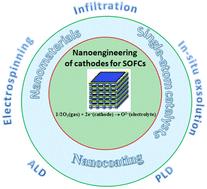当前位置:
X-MOL 学术
›
Inorg. Chem. Front.
›
论文详情
Our official English website, www.x-mol.net, welcomes your
feedback! (Note: you will need to create a separate account there.)
Advances in nanoengineering of cathodes for next-generation solid oxide fuel cells
Inorganic Chemistry Frontiers ( IF 6.1 ) Pub Date : 2024-10-30 , DOI: 10.1039/d4qi02451f Chunwen Sun
Inorganic Chemistry Frontiers ( IF 6.1 ) Pub Date : 2024-10-30 , DOI: 10.1039/d4qi02451f Chunwen Sun

|
In recent years, great efforts have been devoted to develop low or intermediate temperature solid oxide fuel cells (SOFCs) operating at 500–800 °C. Lowering the operating temperature can suppress degradation of components and extend the range of acceptable material selection. Moreover, this is also favorable for improving cell durability and reducing the system cost. However, reducing the operating temperature decreases the electrode kinetics and leads to large interfacial polarization resistances, especially prominent for the oxygen reduction reaction (ORR) at the cathode. This review introduces the research progress of nanoengineering of electrodes employed for SOFCs operating at low and intermediate temperatures, including nanofiber-, nanotube- and nanowire-based cathodes, nanocoatings fabricated by atomic layer deposition (ALD) and pulsed laser deposition (PLD), in situ exsolution nanoparticles from perovskite materials, infiltration nanoparticles, single-atom based cathode catalysts, triple-conducting oxide cathodes, etc. Finally, we also provide future research directions on nanoengineering of cathodes for next-generation SOFCs.
中文翻译:

下一代固体氧化物燃料电池正极纳米工程的进展
近年来,人们投入了大量精力来开发在 500-800 °C 下运行的低温或中温固体氧化物燃料电池 (SOFC)。 降低工作温度可以抑制组件的劣化并扩大可接受的材料选择范围。此外,这也有利于提高电池的耐用性和降低系统成本。然而,降低工作温度会降低电极动力学并导致较大的界面极化电阻,尤其是阴极的氧还原反应 (ORR)。本文介绍了在中低温下工作的 SOFC 电极纳米工程的研究进展,包括基于纳米纤维、纳米管和纳米线的阴极、原子层沉积 (ALD) 和脉冲激光沉积 (PLD) 制备的纳米涂层、钙钛矿材料的原位溶出纳米颗粒、渗透纳米颗粒、单原子基阴极催化剂、三导电氧化物阴极等.最后,我们还为下一代 SOFC 的阴极纳米工程提供了未来的研究方向。
更新日期:2024-10-30
中文翻译:

下一代固体氧化物燃料电池正极纳米工程的进展
近年来,人们投入了大量精力来开发在 500-800 °C 下运行的低温或中温固体氧化物燃料电池 (SOFC)。 降低工作温度可以抑制组件的劣化并扩大可接受的材料选择范围。此外,这也有利于提高电池的耐用性和降低系统成本。然而,降低工作温度会降低电极动力学并导致较大的界面极化电阻,尤其是阴极的氧还原反应 (ORR)。本文介绍了在中低温下工作的 SOFC 电极纳米工程的研究进展,包括基于纳米纤维、纳米管和纳米线的阴极、原子层沉积 (ALD) 和脉冲激光沉积 (PLD) 制备的纳米涂层、钙钛矿材料的原位溶出纳米颗粒、渗透纳米颗粒、单原子基阴极催化剂、三导电氧化物阴极等.最后,我们还为下一代 SOFC 的阴极纳米工程提供了未来的研究方向。


















































 京公网安备 11010802027423号
京公网安备 11010802027423号